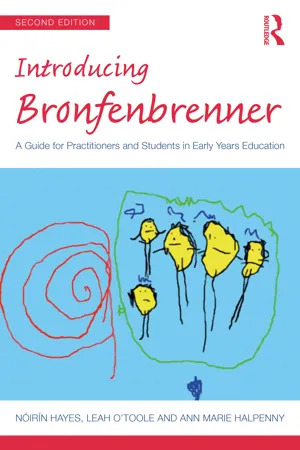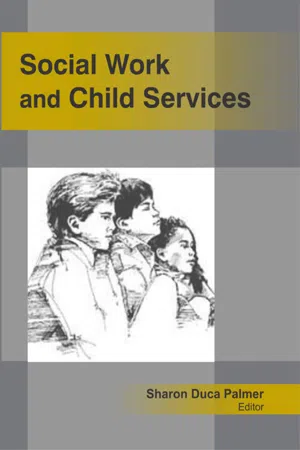Psychology
Environmental Factors in Development
Environmental factors in development refer to the external influences that impact an individual's growth and behavior. These factors can include family dynamics, socioeconomic status, cultural influences, and physical surroundings. Environmental factors play a significant role in shaping an individual's cognitive, emotional, and social development.
Written by Perlego with AI-assistance
Related key terms
1 of 5
10 Key excerpts on "Environmental Factors in Development"
- eBook - ePub
Child and Adolescent Psychology
Typical and Atypical Development
- Stephen von Tetzchner(Author)
- 2018(Publication Date)
- Routledge(Publisher)
CHAPTER 1 DEVELOPMENTAL PSYCHOLOGY P sychology is concerned with human beings’ (and animals’) understanding of the physical and social environment, and the bases for their actions, feelings and experiences, as well as their participation in greater and smaller social networks and in society. Developmental psychology is concerned with how all this comes about, how children gradually change socially, mentally and behaviorally, the underlying processes, and the factors that may influence these changes, for example how children’s understanding of the world and thinking changes over time, what makes children develop different abilities, how children form relationships with parents and peers, why boys and girls tend to play in different ways and come to have different interests and behavior, why some children are socially active and extrovert while others are more shy and careful, and how emotional expressivity differs between cultures. Developmental psychology also includes the developmental courses of children with sensory and physical disabilities, as well as the vulnerability and risk factors that underlie the emergence of learning disorders and emotional and behavioral disorders in childhood and adolescence, and factors that may prevent the development of such disorders. Development can be defined as an age-related process involving changes in the structure and functioning of human beings and animals as a result of interaction between biological structures, psychological states and ecological factors. While the organism adapts to its environment, the environment must also have properties that allow the organism to develop. At the core of the developmental process lies transformation : something new emerges, less becomes more, simplicity turns into complexity, limited skills evolve into advanced mastery (Overton, 2015) - Anne Rinn(Author)
- 2021(Publication Date)
- Routledge(Publisher)
SECTION IVWhat Effect Does the Environment Have on the Development of Psychosocial Skills Conducive to the Development of Talent?
DOI: 10.4324/9781003238058-13This section moves into a deeper examination of aspects of the environment that may impact social, emotional, and psychosocial development. For example, consider the construct of self-beliefs. Previous chapters have examined the notion of self-concept from conceptual and measurement perspectives, how self-beliefs change over time, and how specific self-beliefs can impact talent development, such as stereotype threat, the Big-Fish-Little-Pond Effect, and the imposter phenomenon. However, it can be assumed that an individual will handle the imposter phenomenon, for example, differently in a warm and supportive environment than in one full of microaggressions and real or perceived hostility.The “environment” can be viewed in many ways. As seen in Chapter 1 , both Gagné and Simonton considered the role of nature and nurture in their models of talent development. With regard to nurture, or the environment, in particular, Gagné’s (2017) Integrative Model of Talent Development included three factors that comprise the environmental catalysts that affect talent development: (a) physical, cultural, social, and familial milieu; (b) important individuals in the person’s life, including parents, teachers, and mentors; and (c) resources, including curriculum. Simonton (2017) was less specific in his Multivariate Recursive Model of Talent Development and listed environmental factors that influence cognitive abilities and personality traits.The following chapters explore the role of the environment on the social, emotional, and psychosocial development of high-ability individuals from a variety of perspectives. First, from a systems perspective, Chapter 9 examines the various systems in which an individual interacts and how those interactions impact development. Chapter 10 examines the notion of psychosocial interventions from both a group (affective curriculum) and individual (mentoring) perspective. Chapter 11- eBook - PDF
Environmental Psychology
A Psycho-social Introduction
- Mirilia Bonnes, Gianfranco Secchiaroli(Authors)
- 1995(Publication Date)
- SAGE Publications Ltd(Publisher)
As Little (1987) has pointed out, beginning with the perspective outHned by Brunswik's (1943, 1957) theory of perception, the entire area of psychological research had to look at behaviour from a perspective less anchored to the general laws of intra-individual func-tioning and more attentive to the processes contextually involving persons and their environment. In studies on personality, a paradigmatic example of this approach can be found in the most radical theoretical proposal advanced by Mischel (1968). This author has conceptualized personality by clearly shifting 114 Environmental psychology attention from individual stability (traditionally attributed to internal traits) to 'situational' (context) factors. He considers the situation as responsible for the control of human behaviours and, consequently, for their change. Besides re-proposing the perennial controversy over the importance to be given to internal/external factors in explaining variations and differences in and between individual behaviours, Mischel's proposal on personality probably constitutes another of the premises in the psycho-logical disciplines favouring an interactive (besides a contextual) view or conceptualizing the more general relationship between environment and behaviour. The study of the relationships between personality and environment has been outlined since the beginning as a work programme aimed at constructing a bridge between the individual and the physical components of his/her life contexts, between psychological and environmental disciplines. Perhaps because of its emblematic position, this study figures as an equally emblematic synthesis of the crucial main problems e.p. is also faced with in more specific and circumscribed areas. Environmental attitudes Another route followed by environmental-psychological research in studying evaluative responses to various properties and/or components of the physical environment is the one articulated around attitudes. - Available until 4 Dec |Learn more
Psychological Criminology
An Integrative Approach
- Richard Wortley(Author)
- 2011(Publication Date)
- Willan(Publisher)
This chapter is informed by theories and research in developmental psychology. Developmental psychology is the study of the ways that humans both change and remain constant over time. Developmental psychologists study orderly changes and continuities in three interrelated domains: physical development, cognitive development and psychosocial development. A common misconception about developmental psychology is that it is child psychology. While a great deal of attention in developmental psychology is indeed given to the critical early years of childhood, development continues across the lifespan: from ‘womb to tomb’. Many theorists argue that an individual’s future is not set in concrete by their childhood experiences. Instead, throughout each period of life there are critical transition points that may lead an individual down one pathway or another. The chapter begins by setting out the biological and environmental foundations of development. There follows a review of the critical developmental factors that increase or reduce the risk that an individual will engage in crime. Development in three specific psychological domains particularly relevant to criminology – attachment, moral reasoning and self-control – is then discussed. Finally, the criminal careers perspective is presented, with an examination of variations in offending patterns across the lifespan.The Biological and Environmental Foundations of Human DevelopmentThe focus of this section is on how genes and the environment combine to shape the process of development. The key point to be made is that biosocial processes produce a wide array of developmental possibilities that help account for individual differences in offending patterns. The first task in this analysis is to identify the sources of influence on development.Heritability Revisited: Shared and Non-Shared EnvironmentsAs discussed in Chapter 3 , heritability studies estimate the portion of the variance in a trait that is attributable to genetic factors on the one hand, and environmental factors on the other. These studies have revealed that in general .3–.5 of trait variance is attributable to genetic factors, leaving .5–.7 due to environmental factors. However, in most modern heritability studies, environmental factors are further broken down into shared (or common) environments and non-shared (unique) environments (Plomin et al - eBook - ePub
Introducing Bronfenbrenner
A Guide for Practitioners and Students in Early Years Education
- Nóirín Hayes, Leah O'Toole, Ann Marie Halpenny(Authors)
- 2022(Publication Date)
- Routledge(Publisher)
4 Understanding development in contextDOI: 10.4324/9781003247760-4Introduction
The bioecological model acknowledges that children do not develop in isolation; rather, development is embedded within and across many contexts such as family, home, school, community, society and culture. Young children learn and develop in the midst of society, and the ordinary spaces, places and people they come in contact with have a profound influence on them (Hayes, 2013 ; O’Toole, Hayes, & Halpenny, 2020 ). Each of these ever-changing and multilevel settings influences, either directly or indirectly, the pattern of child development and learning. Such contexts extend beyond the child’s immediate environment (e.g. home and early childhood setting) to encompass the broader sociocultural contexts in which development is embedded.Building on the concepts outlined and discussed in the previous chapters, we now explore the contexts that inform and guide children’s learning and development. Ultimately, all the contextual factors influencing a child operate through the child’s immediate environment – the people, places and things with which the child has direct contact. However, the values of a particular culture are also reflected in the structure of the settings in which children spend their time. This chapter further explores how the bioecological model can offer a framework to incorporate many sociocultural insights on understanding development in context. In particular, we interrogate the idea of ‘internalisation’, or the incorporation of contexts for development into the personal characteristics of the developing child.Bronfenbrenner’s theory highlights the importance of actively linking early years settings to other important environments in the lives of young children as well as understanding the rich “funds of knowledge” (Hedges, 2014 ; Wood, 2013 ) children bring with them from the various contexts in which they are developing. Increasingly, the number and range of contexts young children traverse on a day-to-day basis are expanding, creating a potential for ‘culture shock’ where these are very different (O’Toole et al., 2020 ; O’Toole & Hayes, 2020 ). When the culture of the home and that of the early years setting are different, it may be difficult for children to adjust (Brooker, 2015 ), and this is explored in detail in Chapters 5 and 10 - eBook - PDF
- Sharon Duca Palmer(Author)
- 2016(Publication Date)
- Apple Academic Press(Publisher)
Introduction Although the nature/nurture debate may seem to belong to past history, the ques-tion of how genetic/experiential factors affect behavioural development remains very vivid [1]. Both genetic and environmental factors are involved in the deter-minism of aspects like temperament, but their relative weights may vary accord-ing to the trait being considered [e.g. 2]. As mentioned by Gosling [3], animal studies are very useful as they can reveal the interplay between different factors. Thus, horses with highly sensitive phenotypes [e.g. 4] may develop abnormal be-haviour (such as stereotypies) as a consequence of unfavourable environmental conditions [e.g. 5] (See [6], [7] for reviews). These animal studies provide useful framework to study normal and patho-logical behaviours of humans as a result of such interplay. Thus, twin studies show that parenting influences children’s prosocial behaviours and acts as a “modula-tion” of genetic influences. This is especially true in the case of psychiatric dis-orders: despite a strong genetic basis [8], schizophrenia can been shown to be influenced by parenting profiles [9] as well as by factors such as an infectious dis-ease during mid-pregnancy [10]. The weights attributed to genetic/environmental factors by authors are also often subject to variations along with “science history,” especially where psychiatric disorders are concerned [11]. Thus, Autistic Spectrum Disorders (ASD) characterized by social and com-munication deficits and repetitive or stereotypic behaviour [12] have been for a Environmental Factors Influence Language Development 119 long while attributed to environmental factors such as mothering (i.e. “refrigera-tor mother” [13]) or diseases (e.g. congenital rubella [14]). After reacting against the theory of lack of maternal affection during the ‘50s and ‘60s, research radi-cally turned towards a neural and cognitive hypothesis [e.g. 15]. - No longer available |Learn more
- (Author)
- 2014(Publication Date)
- The English Press(Publisher)
________________________ WORLD TECHNOLOGIES ________________________ Chapter-1 Developmental Psychology Developmental psychology , also known as human development , is the scientific study of systematic psychological changes that occur in human beings over the course of their life span. Originally concerned with infants and children, the field has expanded to include adolescence, adult development, aging, and the entire life span. This field exa-mines change across a broad range of topics including motor skills and other psycho-physiological processes; cognitive development involving areas such as problem solving, moral understanding, and conceptual understanding; language acquisition; social, personality, and emotional development; and self-concept and identity formation. Developmental psychology includes issues such as the extent to which development occurs through the gradual accumulation of knowledge versus stage-like development, or the extent to which children are born with innate mental structures versus learning through experience. Many researchers are interested in the interaction between personal characteristics, the individual's behavior, and environmental factors including social context, and their impact on development; others take a more narrowly focused approach. Developmental psychology informs several applied fields, including: educational psychology, child psychopathology, and forensic developmental psychology. Develop-mental psychology complements several other basic research fields in psychology including social psychology, cognitive psychology, ecological psychology, and compara-tive psychology. - No longer available |Learn more
- (Author)
- 2014(Publication Date)
- College Publishing House(Publisher)
______________________________ WORLD TECHNOLOGIES ______________________________ Chapter 7 Developmental Psychology Developmental psychology , also known as human development , is the scientific study of systematic psychological changes that occur in human beings over the course of their life span. Originally concerned with infants and children, the field has expanded to include adolescence, adult development, aging, and the entire life span. This field examines change across a broad range of topics including motor skills and other psycho-physiological processes; cognitive development involving areas such as problem solving, moral understanding, and conceptual understanding; language acquisition; social, personality, and emotional development; and self-concept and identity formation. Developmental psychology includes issues such as the extent to which development occurs through the gradual accumulation of knowledge versus stage-like development, or the extent to which children are born with innate mental structures versus learning through experience. Many researchers are interested in the interaction between personal characteristics, the individual's behavior, and environmental factors including social context, and their impact on development; others take a more narrowly focused approach. Developmental psychology informs several applied fields, including: educational psychology, child psychopathology, and forensic developmental psychology. Developmental psychology complements several other basic research fields in psychology including social psychology, cognitive psychology, ecological psychology, and comparative psychology. - eBook - ePub
The Language of Winnicott
A Dictionary of Winnicott's Use of Words
- Jan Abram(Author)
- 2018(Publication Date)
- Routledge(Publisher)
Environment1 The impact of the environment on human development 2 The analytic setting—a holding environment 3 Psychosis—an environmental deficiency disease 4 Psychotic anxiety 5 Impingement 6 Fear of breakdown 7 “We are poor indeed if we are only sane” 8 Father—the indestructible environment Winnicott’s theory of emotional development lays an emphasis on the psychic environment and its responsibility for the emotional health of the infant.The first environment for the infant is mother, and at the beginning they are merged together in an environment–individual set-up.The emotional environment cannot be held totally responsible for what becomes of the infant in terms of his mental health; it can only provide a spectrum of available experience: at the good end it is facilitating, at the other it is damaging.The facilitating environment enables the individual to take the opportunity to grow and will usually lead to health, whereas the emotional environment that fails, particularly in the beginning, is more likely to lead to mental instability and ill health.1 The impact of the environment on human developmentPsychoanalytic literature makes reference to the mother’s role in relation to her infant, but, in the main, until around 1950, the theoretical thrust had been very much on the individual and his inner world. The impact of the environment on the mental health of the individual had not really been accorded the importance it has since held in analytic theory, and Winnicott’s contribution is seminal.In 1942, Winnicott found himself jumping up in a meeting and saying, “There’s no such thing as a baby!” It was, for him, a moment of true discovery, which he relates ten years later, in his paper, “Anxiety Associated with Insecurity”, presented to the British Psycho-Analytical Society in 1952. The individual was from then on no longer a unit, but an environment–individual set-up—the nursing couple.. . . if you show me a baby you certainly show me also someone caring for the baby, or at least a pram with someone’s eyes and ears glued to it. One sees a nursing couple . . . before object relationships the state of affairs is this: that the unit is not the individual, the unit is the environment–individual set-up. The centre of gravity of the being does not start off in the individual. It is in the total set-up. - eBook - ePub
Education and the Family
Passing Success Across the Generations
- Leon Feinstein, Kathryn Duckworth, Ricardo Sabates(Authors)
- 2008(Publication Date)
- Routledge(Publisher)
It is important to note that the specific influence of parents’ education as a key driver in inequalities has rarely been the focus of investigation. Associations here have more commonly been made with related distal features, such as family income or social class. However, there are good theoretical grounds to believe that education itself has a real and important part to play in these relationships. These theoretical connections are made for each of the three developmental contexts examined here, and empirical evidence is evaluated where it exists. Where it does not, we make hypotheses about the likely mechanisms for education effects based on the evidence of associations found with other features of the family background.Conceptualising the importance of other contexts and their relationship to the family
In Bronfenbrenner’s (1979) ecological model, context is defined as the location and/or institutional locale within which particular sets of processes occur. These contexts are conceptualised as being developmentally appropriate (constructive) or inappropriate (destructive) depending on whether they are positively or negatively associated with patterns of achievement, behaviour, motivation and mental health. In infancy, key contexts typically include the family and pre-school or other childcare settings. As children get older, they enter more formal education institutions and so schools, after-school settings, extra-curricular activities and the peer group become important places of influence on the developing individual. The effects of different social contexts vary with the particular characteristics of the child. The peer group, for example, becomes increasingly influential during adolescence and into young adulthood. Accordingly, relations within a neighbourhood change considerably and so influences on a young child are very different than for an adolescent. Handler et al
Index pages curate the most relevant extracts from our library of academic textbooks. They’ve been created using an in-house natural language model (NLM), each adding context and meaning to key research topics.









